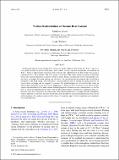| dc.contributor.author | Liang, Xinfeng | |
| dc.contributor.author | Wunsch, Carl | |
| dc.contributor.author | Heimbach, Patrick | |
| dc.contributor.author | Forget, Gael | |
| dc.date.accessioned | 2015-12-17T20:39:33Z | |
| dc.date.available | 2015-12-17T20:39:33Z | |
| dc.date.issued | 2015-05 | |
| dc.date.submitted | 2015-02 | |
| dc.identifier.issn | 0894-8755 | |
| dc.identifier.issn | 1520-0442 | |
| dc.identifier.uri | http://hdl.handle.net/1721.1/100418 | |
| dc.description.abstract | Estimated values of recent oceanic heat uptake are on the order of a few tenths of a W m[superscript −2], and are a very small residual of air–sea exchanges, with annual average regional magnitudes of hundreds of W m[superscript −2]. Using a dynamically consistent state estimate, the redistribution of heat within the ocean is calculated over a 20-yr period. The 20-yr mean vertical heat flux shows strong variations in both the lateral and vertical directions, consistent with the ocean being a dynamically active and spatially complex heat exchanger. Between mixing and advection, the two processes determining the vertical heat transport in the deep ocean, advection plays a more important role in setting the spatial patterns of vertical heat exchange and its temporal variations. The global integral of vertical heat flux shows an upward heat transport in the deep ocean, suggesting a cooling trend in the deep ocean. These results support an inference that the near-surface thermal properties of the ocean are a consequence, at least in part, of internal redistributions of heat, some of which must reflect water that has undergone long trajectories since last exposure to the atmosphere. The small residual heat exchange with the atmosphere today is unlikely to represent the interaction with an ocean that was in thermal equilibrium at the start of global warming. An analogy is drawn with carbon-14 “reservoir ages,” which range from over hundreds to a thousand years. | en_US |
| dc.description.sponsorship | National Science Foundation (U.S.) (Grant OCE-0961713) | en_US |
| dc.description.sponsorship | United States. National Oceanic and Atmospheric Administration (Grant NA10OAR4310135) | en_US |
| dc.language.iso | en_US | |
| dc.publisher | American Meteorological Society | en_US |
| dc.relation.isversionof | http://dx.doi.org/10.1175/jcli-d-14-00550.1 | en_US |
| dc.rights | Article is made available in accordance with the publisher's policy and may be subject to US copyright law. Please refer to the publisher's site for terms of use. | en_US |
| dc.source | American Meteorological Society | en_US |
| dc.title | Vertical Redistribution of Oceanic Heat Content | en_US |
| dc.type | Article | en_US |
| dc.identifier.citation | Liang, Xinfeng, Carl Wunsch, Patrick Heimbach, and Gael Forget. “Vertical Redistribution of Oceanic Heat Content.” J. Climate 28, no. 9 (May 2015): 3821–3833. doi:10.1175/jcli-d-14-00550.1. | en_US |
| dc.contributor.department | Massachusetts Institute of Technology. Department of Earth, Atmospheric, and Planetary Sciences | en_US |
| dc.contributor.mitauthor | Liang, Xinfeng | en_US |
| dc.contributor.mitauthor | Heimbach, Patrick | en_US |
| dc.contributor.mitauthor | Forget, Gael | en_US |
| dc.relation.journal | Journal of Climate | en_US |
| dc.eprint.version | Final published version | en_US |
| dc.type.uri | http://purl.org/eprint/type/JournalArticle | en_US |
| eprint.status | http://purl.org/eprint/status/PeerReviewed | en_US |
| dspace.orderedauthors | Liang, Xinfeng; Wunsch, Carl; Heimbach, Patrick; Forget, Gael | en_US |
| dc.identifier.orcid | https://orcid.org/0000-0002-5628-4896 | |
| dc.identifier.orcid | https://orcid.org/0000-0003-3925-6161 | |
| mit.license | PUBLISHER_POLICY | en_US |
| mit.metadata.status | Complete | |
